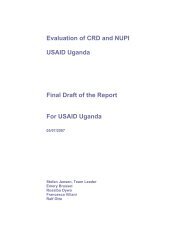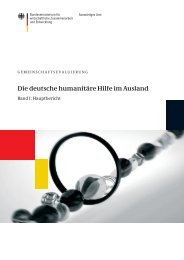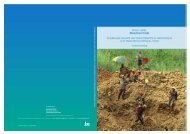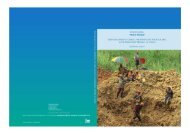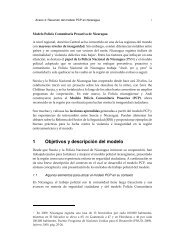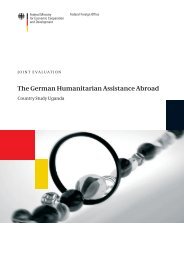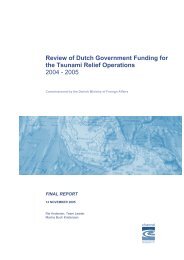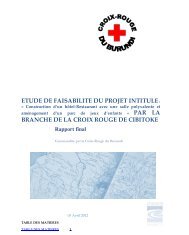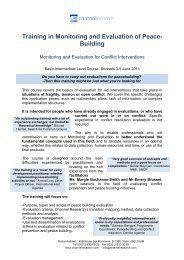A ripple in development? - Channel Research
A ripple in development? - Channel Research
A ripple in development? - Channel Research
You also want an ePaper? Increase the reach of your titles
YUMPU automatically turns print PDFs into web optimized ePapers that Google loves.
Indonesia also has new legislation and new <strong>in</strong>stitutions, but they<br />
are still not fully operational. Guidel<strong>in</strong>es are still be<strong>in</strong>g developed and<br />
roles and responsibilities still need to be clearly def<strong>in</strong>ed. However, there<br />
is a clear will<strong>in</strong>gness to improve and build appropriate disaster management<br />
systems, which will take time. There is a shift from focus<strong>in</strong>g only<br />
on response to also <strong>in</strong>clude preparedness, a dimension reflected <strong>in</strong> the<br />
new laws and guidel<strong>in</strong>es.<br />
The Maldives had undertaken some tra<strong>in</strong><strong>in</strong>g and rehearsals for<br />
small-scale disasters before the tsunami, but there was no preparation or<br />
tra<strong>in</strong><strong>in</strong>g for large-scale disasters. The Maldives has created some of the<br />
<strong>in</strong>stitutions necessary for Disaster Risk Management 70 such as the<br />
NDMC, but the Disaster Management Act 71 is still <strong>in</strong> draft form. For<br />
the Maldives the biggest threat is probably climate change rather than<br />
seismic disaster events. Climate change will be experienced <strong>in</strong>itially as<br />
<strong>in</strong>creased frequency of disaster events such as floods and tidal surges,<br />
and possibly more frequent or destructive tropical cyclones 72 .<br />
5.3 Changes <strong>in</strong> organisational knowledge<br />
The Document Review has highlighted the degree to which there an<br />
<strong>in</strong>creas<strong>in</strong>g volume of documents published on disaster risk reduction by<br />
<strong>in</strong>ternational, governmental and NGO <strong>in</strong>stitutions. The aftermath of<br />
the tsunami has prompted a great deal of research on tsunamis and the<br />
extent of the tsunami hazard. As recently as 2004 a manual on community-based<br />
disaster risk management <strong>in</strong> the region barely referred to<br />
tsunamis 73 . S<strong>in</strong>ce the tsunami there has been a great deal of attention to<br />
at least the tsunami risk, with <strong>in</strong>vestigation <strong>in</strong>to historic tsunamis to<br />
establish their past occurrence and likely return period 74 .<br />
In Sri Lanka there was also some evidence that attention to and<br />
knowledge of other hazards was grow<strong>in</strong>g. The reasons for this were<br />
70<br />
Muhus<strong>in</strong>, A. (2007). Disaster Risk Reduction through people centered National Multi Multi-hazard<br />
Early Warn<strong>in</strong>g System <strong>in</strong> the context of Maldives Paper presented at the Fourth Technical Conference<br />
on Management of Meteorological and Hydrological Services <strong>in</strong> Asia Islamabad, 5–9 February<br />
2007.<br />
71<br />
Disaster Management Act 2006, revised on 3rd October 2007 (not yet enacted). (2007).<br />
72<br />
A recent report from the World Bank notes that while the <strong>in</strong>cidence of natural disasters is <strong>in</strong>creas<strong>in</strong>g<br />
the <strong>in</strong>cidence of flood<strong>in</strong>g and w<strong>in</strong>dstorms is <strong>in</strong>creas<strong>in</strong>g much more rapidly than for other types<br />
of natural disasters. Parker, R., Little, K., & Heuser, S. (2007). Development Actions and the<br />
Ris<strong>in</strong>g Incidence of Disasters (Evaluation Brief 4). Wash<strong>in</strong>gton: World Bank.<br />
73<br />
Abarquez, I., & Murshed, Z. (2004). Community-based disaster risk management: field practitioner’s<br />
handbook. Bangkok: Asia Disaster Preparedness Center.<br />
74<br />
Bondevik, S. (2008). Earth science: The sands of tsunami time. Nature, 455(7217), 1183–1184.<br />
Dahanayake, K., & Kulasena, N. (2008). Geological Evidence for Paleo-Tsunamis <strong>in</strong> Sri Lanka.<br />
Science of Tsunami Hazards, 27(2), 54–61. Ikelman, J. (2007, 03 October). There and Back Aga<strong>in</strong>:<br />
Old Tsunami Data Come Full Circle. Jankaew, K., Atwater, B. F., Sawai, Y., Choowong, M., Charoentitirat,<br />
T., Mart<strong>in</strong>, M. E., & Prendergast, A. (2008). Medieval forewarn<strong>in</strong>g of the 2004 Indian Ocean<br />
tsunami <strong>in</strong> Thailand. Nature, 455(7217), 1228–1231. Monecke, K., F<strong>in</strong>ger, W., Klarer, D., Kongko,<br />
W., McAdoo, B. G., Moore, A. L., & Sudrajat, S. U. (2008). A 1,000-year sediment record of tsunami<br />
recurrence <strong>in</strong> northern Sumatra. Nature, 455(7217), 1232–1234. Wattegama, C. (2005,<br />
January). The seven tsunamis that hit the isle of Lanka. Retrieved 21 November 2008<br />
89




